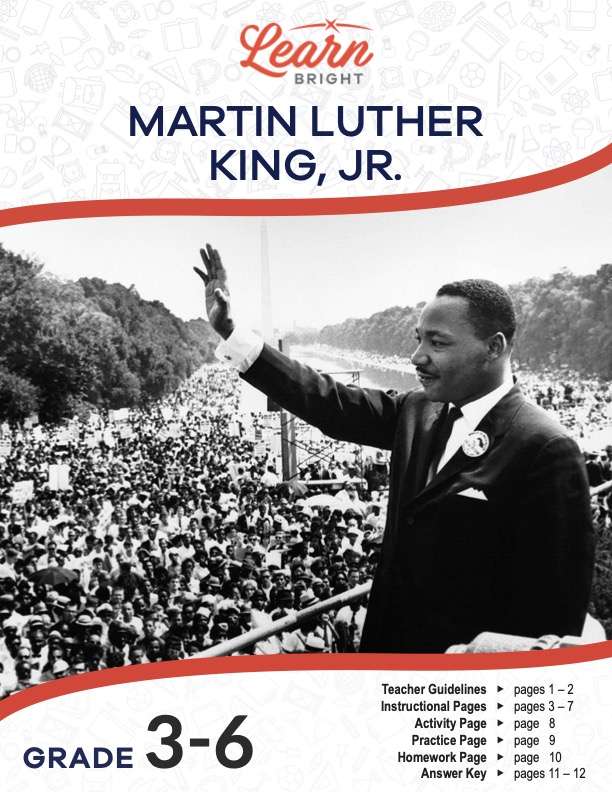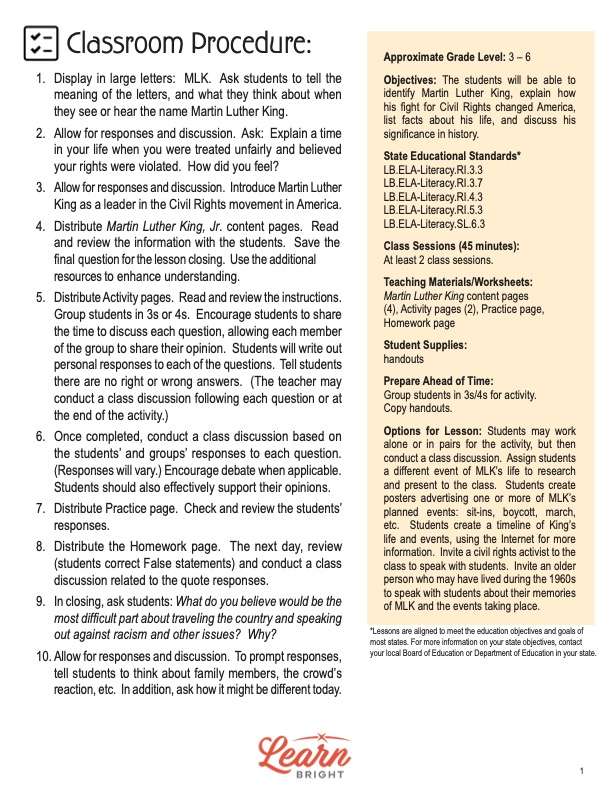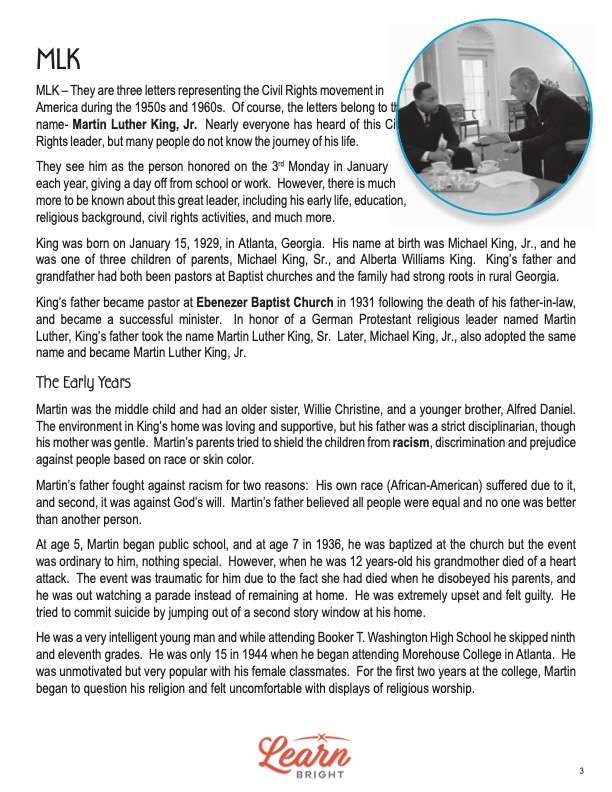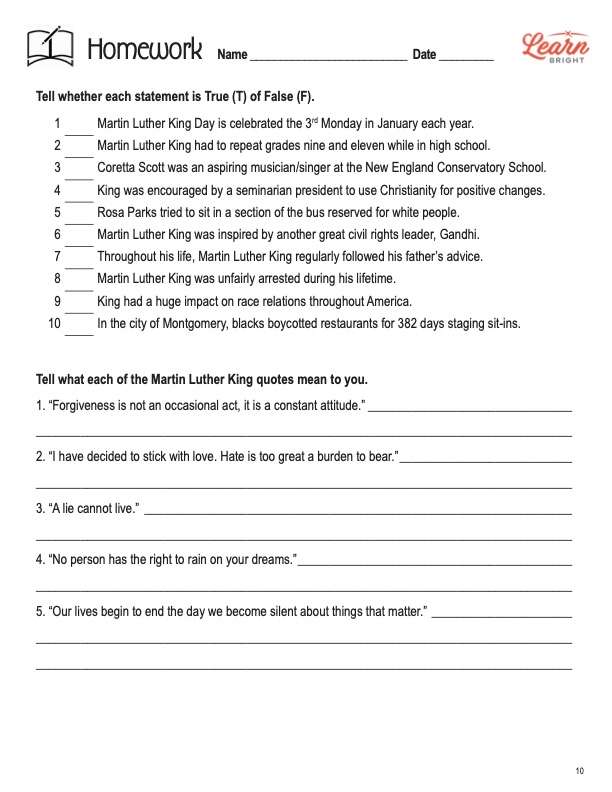Description
What our Martin Luther King, Jr. lesson plan includes
Our Martin Luther King, Jr. lesson plan introduces students to a great Civil Rights leader in the United States. Students are taken on a journey of King’s life and learn about the significance, influence, and impact he had on America during his time as a leader for the Civil Rights movement in America during the 1950s and 1960s. Most students are aware that we celebrate MLK Day in February of each year, but may not know the story behind this incredible role model and leader, and how his words and actions have changed many lives. At the end of the lesson, students will be able to identify Martin Luther King, explain how his fight for Civil Rights changed America, list facts about his life, and discuss his significance in history. This lesson is for students in 3rd grade, 4th grade, 5th grade, and 6th grade.
Classroom Procedure
Every lesson plan provides you with a classroom procedure page that outlines a step-by-step guide to follow. You do not have to follow the guide exactly. The guide helps you organize the lesson and details when to hand out worksheets. It also lists information in the orange box that you might find useful. You will find the lesson objectives, state standards, and number of class sessions the lesson should take to complete in this area. In addition, it describes the supplies you will need as well as what and how you need to prepare beforehand. For this lesson, the only supplies you need are the handouts. To prepare for this lesson ahead of time, you can group students for the activity and copy the handouts.
Options for Lesson
Included with this lesson is an “Options for Lesson” section that lists a number of suggestions for activities to add to the lesson or substitutions for the ones already in the lesson. For this lesson, there are many options. You can have students do an extra research assignment on a specific event from MLK’s life. Students can create a poster to advertise one or more of the events that MLK helped organize, such as sit-ins, boycotts, or marches. You can also have students create a timeline of King’s life. You can find additional suggestions and options on the Classroom Procedure page of the lesson.
Teacher Notes
The teacher notes page includes a paragraph with additional guidelines and things to think about as you begin to plan your lesson. This page also includes lines that you can use to add your own notes as you’re preparing for this lesson.
MARTIN LUTHER KING, JR. LESSON PLAN CONTENT PAGES
The Early Years
The Martin Luther King, Jr. lesson plan contains five content pages. Students will first learn that MLK (his initials) have come to represent the civil rights movement in America during the 1950s and 1960s. Martin Luther King, Jr., was born in 1929 on January 15 in the city of Atlanta, Georgia. His given name at birth was actually Michael King, Jr., after his father.
Both MLK’s father and grandfather had been pastors at Baptist churches, and the family had strong roots in rural Georgia. King’s father became a pastor at Ebenezer Baptist Church in 1931 and became a successful minister. In honor of a German Protestant religious leader named Martin Luther, King’s father adopted the name Martin Luther King, Sr. Not too long after, MLK adopted the name himself and became Martin Luther King, Jr.
MLK’s parents always tried to shield their children from racism, discrimination and prejudice against people based on race or skin color. Martin’s father fought against racism for two reasons: his own race suffered for it, and it was against God’s will. He knew that all people were created equal, that no one was better than another person.
Growing Up
MLK was a very intelligent young man. While attending Booker T. Washington High School, he skipped ninth and eleventh grades. He was only 15 in 1944 when he began attending Morehouse College in Atlanta. He was unmotivated but very popular with his female classmates. For the first two years at the college, Martin began to question his religion and felt uncomfortable with displays of religious worship.
Though his parents were not happy, Martin chose not to enter the ministry or follow in the footsteps of his father and grandfather. A couple years later, during his junior year in college, Martin attended a Bible class, which led him to change his mind. It strengthened his faith, and he looked forward to a career in the ministry.
In 1948, King graduated from the college, earning a degree in sociology. He attended Crozer Theological Seminary in Chester, Pennsylvania. Once again, the intelligent young man excelled in his studies, became class president, and was the valedictorian of his class. At the same time, though, he began to rebel against his father’s influence and started to drink beer, play pool, and became involved with a white woman at the school. These were all things that were against his upbringing.
Things changed for King during his last year at the seminary when the president of the college began to influence his spiritual development. Benjamin E. Mays advocated for racial equality and encouraged King to see Christianity as a force for positive changes in society. After graduation from the seminary, King entered Boston University to work on his doctorate.
It was in Boston where he met his future wife, Coretta Scott, who was an aspiring musician and singer. In June of 1953, Martin and Coretta married and later had four children. He then became pastor of the Dexter Avenue Baptist Church in Montgomery, Alabama. Two years following his marriage, King received his PhD at age 25, thus becoming Dr. Martin Luther King, Jr.
Bus Boycott
December 1, 1955, is often the day we recognize as King’s entry into the civil rights movement in America. On that day, Rosa Parks at 42 years old boarded a bus following a day at work. She sat in the first row of the “colored” section of the bus. Segregation laws were numerous throughout the South. The bus began to fill with white passengers, and Rosa was ordered by the driver to give up her seat to a white person. She refused and remained seated. As a result, she was arrested and later found guilty and fined $10.
On the night of the arrest, Martin Luther King, Jr., and other civil rights leaders met and decided to plan a boycott of the city’s bus system. Since many African-Americans used the buses, it would cause a financial loss for the city of Montgomery. King was chosen to lead the boycott. He was young, well trained, and had family connections. The group believed he had credibility with the black community.
The boycott lasted for 382 days. King’s and other leaders’ homes were vandalized. Blacks were harassed and intimidated and had to face violence. The bus boycott itself, however, was peaceful. The African-American community took legal action against the city, stating the law was unconstitutional based on the recent desegregation of schools that “separate is never equal.” Montgomery indeed suffered financially. After several lower court rulings against them, the law was lifted, and people could sit anywhere on buses.
MLK—A Leader for Civil Rights
It was King’s first victory in the civil rights movement, but the road ahead would not be easy. Several of the leaders decided a national organization was necessary. King and others formed the Southern Christian Leadership Conference (SCLC) in January of 1957 as a result. Their purpose was to organize black churches, conduct non-violent protests, and promote civil rights reforms.
The first goal of the group was to register black voters in cities throughout the South. At the same time, King met with religious and civil rights leaders throughout the country and lectured listeners on race-related issues. While in India in 1959, King was inspired during a visit to Gandhi’s birthplace. He became further committed to non-violent activism and the American civil rights struggle.
In 1960, non-violent protests called “sit-ins” by African-American college students at racially segregated lunch counters took place in Greensboro, North Carolina. The students refused to leave their seats when asked, which led to their being verbally and physically abused. The movement grew to other areas of the South. King continued to encourage the students to use non-violence for protests. The sit-ins were successful in 27 cities, effectively ending segregation.
Demonstrations and Marches
In the Spring of 1963, King organized a demonstration in Birmingham, Alabama, which included entire families. The city police aggressively dispelled the peaceful protestors using dogs and fire hoses. King was jailed, and while there, he wrote out his theory of non-violence: Non-violent direct action seeks to create such a crisis and foster such a tension that a community, which has constantly refused to negotiate, is forced to confront the issue.
Students will learn that the greatest moment in King’s life was most likely his “I Have a Dream” speech, following the historic March on Washington that drew a crowd of more than 200,000 people. The march inspired and changed the minds of many people throughout the country, leading to the Civil Rights Act of 1964. The act authorized the federal government to enforce desegregation of all public places and outlawed discrimination. For his efforts, King received the Nobel Peace Prize in 1964.
Throughout the 1960s, the struggle continued, however. On March 7, 1965, a march from Selma to Montgomery, AL, turned violent. Police officers used night sticks and tear gas to prevent the marchers from crossing the Edmund Pettus Bridge. Marchers suffered terrible treatment and injuries, and many were hospitalized. King participated in another march that took place three days later. About 2,500 others accompanied him. Instead of trying to cross the same bridge, King led the marchers to kneel in prayer and then turn back.
The governor of Alabama, George Wallace, tried to prevent further marches, but President Lyndon Johnson intervened and ordered the US Army and Alabama National Guard to protect the protestors. A final march took place between Selma and Montgomery. Roughly 25,000 protestors arrived to the state capitol building where King gave a televised speech. Five months later, Johnson signed the 1965 Voting Rights Act, giving African-Americans the same opportunity to vote as all Americans.
Assassination of Martin Luther King, Jr.
Martin Luther King’s civil rights activism continued to spread throughout America. However, there was an increase of challenges to King from young black power leaders. His non-violent approach was criticized by those who thought King was too weak, and they wanted to stage more aggressive protests.
King began to speak out against the Vietnam War and linked discrimination with poverty. He wanted to bring together all races and form a group of people to address the problems of all disadvantaged people. By 1968, King became tired of the marches, the arrests, and the death threats. He was becoming discouraged, but there were plans for one final march.
On April 3, he gave another famous speech titled, “I’ve Been to the Mountaintop.” He assured the listeners that one day they will arrive “to the promised land” but that he may not be there with them. Tragically, while standing on the balcony outside a motel room just three days later in Memphis, Tennessee, Martin Luther King, Jr., was assassinated by a sniper’s bullet. The shooter was a dissatisfied transient and ex-convict, James Earl Ray. He was arrested following a nationwide two-month search. The shooting led to riots and chaos in more than 100 cities across the country.
King died at age 39 on April 3, 1968. Though a young man, he had a huge impact on race relations throughout America and was the most well-known African-American during his lifetime and beyond. He will always be remembered as an influential leader who was committed to non-violent protests to achieve social justice for all people.
MARTIN LUTHER KING, JR. LESSON PLAN WORKSHEETS
The Martin Luther King, Jr. lesson plan includes three worksheets: an activity worksheet, a practice worksheet, and a homework assignment. You can refer to the guide on the classroom procedure page to determine when to hand out each worksheet. All of these worksheets test the student’s knowledge and understanding of the lesson material.
QUESTIONS AND RESPONSES ACTIVITY WORKSHEET
The activity worksheet for this lesson will require students to work with their group members to review and discuss five different questions/responses. Each group member will have an equal amount of time to share their thoughts on each question and will write those thoughts down. Once students have discussed within their groups, they will share with the class during a class discussion.
MATCHING PRACTICE WORKSHEET
There are several sections on the practice worksheet. The first requires students to match descriptions with the person they represent. There are eight descriptions and options in the word bank. For the next section, students will match descriptions to places or things. This section contains seven prompts and seven options. Finally, students will place events in chronological order from 1 (earliest) to 10 (latest).
MARTIN LUTHER KING, JR. HOMEWORK ASSIGNMENT
For the homework assignment, students will first read 10 statements and decide whether they are true (T) or false (F). They will then read various quotes from MLK’s life and write down what those quotes mean to them.
Worksheet Answer Keys
This lesson plan includes answer keys for the the practice worksheet and the homework assignment. Correct answers are in red to make it easy to compare them with students’ work. Given the nature of the second section of the homework assignment, students’ responses will vary. If you choose to administer the lesson pages to your students via PDF, you will need to save a new file that omits these pages. Otherwise, you can simply print out the applicable pages and keep these as reference for yourself when grading assignments.










